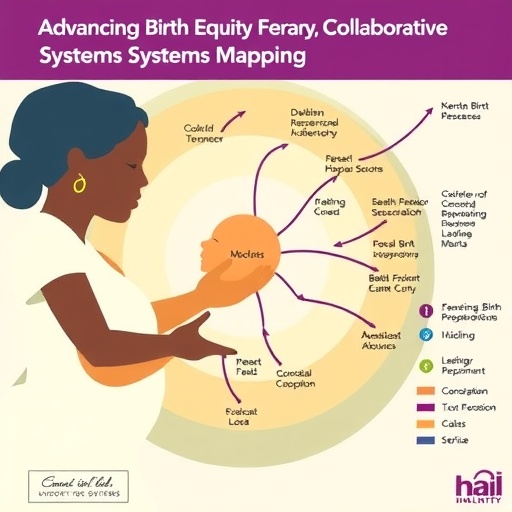In the landscape of public health, one of the most pressing challenges we face is ensuring equitable access to maternal health services. Understanding that disparities in birth outcomes are often entrenched within complex sociopolitical and economic systems is crucial for addressing these inequities. A recent study led by Thomas et al., highlighted in Health Research Policy and Systems, offers a groundbreaking approach to fostering birth equity through the innovative lens of collaborative systems mapping. This paper is not just a detailed analysis; it is a clarion call for action in dismantling the barriers that perpetuate birth inequities.
The essence of the research lies in its rigorous methodology, which applies collaborative systems mapping to untangle the multifaceted factors affecting maternal and infant health across different populations. Traditional models of healthcare delivery frequently fail to account for the intricate web of social determinants—ranging from socioeconomic status, education access, racial disparities, and even legislative influences—that converge to shape health outcomes. The authors advocate for viewing these factors not in isolation but as interlinked components of a larger system.
What’s particularly intriguing about their approach is the participatory nature of systems mapping. By integrating voices from various stakeholders including healthcare providers, policymakers, and affected communities, the researchers have built a comprehensive framework for understanding and addressing inequities in maternal health. This methodology not only highlights the importance of inclusivity in public health decision-making but also demonstrates how collective insight can lead to more robust and sustainable solutions.
The results of the systems mapping highlighted specific leverage points within the healthcare system—opportunities to implement interventions that could significantly enhance birth equity. For instance, the study revealed that improved coordination among health services can bridge gaps in care for disadvantaged populations, ensuring that these groups receive not only equitable care but also culturally competent support throughout their pregnancy journeys. Such a shift toward a more holistic approach in healthcare provision can fill long-standing voids in service delivery.
Furthermore, the authors emphasize the role of data in driving change. By collecting and analyzing qualitative data from diverse populations, they were able to paint a vivid picture of the lived experiences of those most affected by disparities. This data-driven approach serves as a powerful tool in advocating for policy changes at local, regional, and national levels. Effective use of evidence-based findings can mobilize stakeholders toward a common goal: achieving equitable birth outcomes for all.
The implications of this research extend beyond the immediate realm of maternal health. By demonstrating that birth equity is an outcome of collective societal effort rather than isolated interventions, the findings encourage a broader discourse on health disparities across various domains. Birth equity is a reflection of broader systemic issues such as poverty, education, and access to resources. Therefore, any intervention geared toward improving maternal health outcomes must also address these upstream determinants.
One of the compelling aspects of the authors’ findings is their emphasis on adaptability. The systems mapping framework allows for flexible application across different contexts, making it an invaluable resource for regions with varying socio-economic landscapes. Whether in urban centers plagued by healthcare deserts or rural areas lacking infrastructure, this approach can be tailored to meet specific needs. Consequently, collaborative systems mapping could serve as a standard practice for future public health initiatives aimed at optimizing maternal health.
Moreover, the study raises critical questions about the role of technology in enhancing healthcare delivery. As the landscape of public health continuously evolves with advancements in technology, it is imperative to explore how tools such as telemedicine can bridge the gap in access to care. The research suggests that incorporating technological innovations into maternal health services can remove barriers, especially for those who encounter difficulty in attending in-person consultations.
As a call to action, the authors urge healthcare leaders and policymakers to prioritize and invest in research that explores the interconnectedness of various determinants of health. They assert that this investment will yield more profound insights into the systematic changes needed to promote birth equity. Additionally, fostering collaborations between public health institutions, community organizations, and advocates can unify efforts toward a shared vision of health equity.
The momentum created by this research has the potential to inspire a global conversation about maternal health equity. Countries around the world face similar challenges; hence, applying the lessons learned from this study could be instrumental in fostering international collaborations aimed at reducing maternal mortality rates and enhancing healthy pregnancies. The urgency for international partnerships becomes apparent when considering the high rates of maternal mortality in low- and middle-income countries, where systemic inequities are pronounced.
In conclusion, the groundbreaking study conducted by Thomas and colleagues presents an essential framework for addressing birth equity through collaborative systems mapping. As public health continues to grapple with the repercussions of entrenched inequalities, it is imperative to shift our focus toward systematic approaches that empower communities and stakeholders alike. By adopting methodologies that encourage collaboration and inclusion, we can cultivate a more equitable landscape for maternal health—ensuring better outcomes for future generations.
Equipped with these insights and innovative approaches, the hope for a future where every individual has access to equitable maternal healthcare becomes increasingly tangible. The collective responsibility rests on all sectors of society, from healthcare leaders to policymakers and community members, to undertake this journey toward birth equity, paving the way for a healthier, more just world.
Subject of Research: Collaborative systems mapping for birth equity
Article Title: Accelerating birth equity using collaborative systems mapping
Article References: Thomas, S.R., Fatima, H., Simon, J. et al. Accelerating birth equity using collaborative systems mapping. Health Res Policy Sys 23, 128 (2025). https://doi.org/10.1186/s12961-025-01373-1
Image Credits: AI Generated
DOI: 10.1186/s12961-025-01373-1
Keywords: Birth equity, collaborative systems mapping, maternal health, healthcare disparities, public health policy, systemic interventions.




